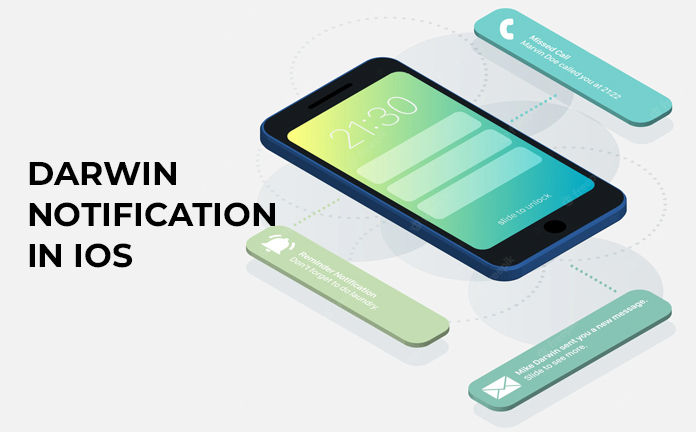Darwin Notification in iOS

This section portrays how to send and get Darwin notices. The Darwin notice framework is moderately clear for designers comfortable with programming in other UNIX/Linux working frameworks. It ties into normally utilized frameworks, for example, document descriptors and signs to give conveyance of messages to the customer procedure.
Darwin notices are bolstered by the notifyd daemon, a procedure that tunes in for approaching notices and redelivers those warnings to intrigued forms in an assortment of ways.
What is Darwin Notification?
In iOS, Darwin notifications are a type of push notification that are sent to iOS devices using Apple’s Darwin Notification Center. This service allows applications to send notifications to the user even when the app is not running. These notifications can include alerts, sounds, and badges.
They can be used to inform the user of new information, such as incoming messages or upcoming events, and can also be used to trigger background processes or update the application’s data. Darwin notifications are one of the key ways that iOS apps can stay connected to users and provide timely and relevant information.
Counting Relevant Headers
When composing a device that utilizations Darwin notices, the accompanying headers are normally used:
Sending Notifications
Sending a Darwin notice is exceptionally straightforward. Simply call the capacity notify_post. The capacity takes a solitary contention that contains the name of the warning. (Perceive How Should Notifications Be Named? for data about warning naming.)
For instance, in the event that you incorporate notices into the Apache web server and need to advise it that its setup document has transformed, you may send the warning with a call like the accompanying:
Getting Notifications
Darwin warnings give five components to getting notices: Core Foundation, record descriptors, signals, Mach messages, and manual surveying. This area depicts these conveyance instruments and clarifies when you ought to pick every one.
While adding notice support to existing applications, you ought to pick whichever component is most straightforward to coordinate into the application or device. On the off chance that your application as of now utilizes flag dealing with, you should utilize signals. On the off chance that your application as of now utilizes attachments or document descriptors, you should utilize record descriptors.
In the event that you are composing another application starting with no outside help, Core Foundation notices are suggested if your application depends on Core Foundation. For non-Core Foundation applications, document descriptors are the favoured warning transport since they are stronger against message misfortune than signals and are simpler to use than Mach messages.
Once more, you ought to pick the system that most nearly fits the engineering of the apparatus you are composing.
When in doubt, you ought to abstain from utilizing the surveying interface (portrayed in Receiving Notifications Manually). You should utilize surveying just in the event that you have to check for a status change rarely.
Accepting Notifications Using Core Foundation
To enlist for Darwin warnings utilizing Core Foundation, first make a notice focus by calling “CFNotificationCenterGetDarwinNotifyCenter”. This makes a protest that communicates with the warning daemon for your sake.
Next, call “CFNotificationCenterAdd犀利士 Observer”. This capacity teaches the warning focus to enrol for notices with the notice daemon.
The accompanying piece demonstrates to enrol for the notice portrayed in Sending Notifications:
….
Benefits and Importance of Darwin Notifications for iOS Apps
Darwin notifications are an essential tool for iOS app developers, allowing them to stay connected with their users and provide timely, relevant information, and improve app performance.
Below are some of the key benefits of Darwin Notifications –
Keeping Users Engaged
Darwin notifications allow apps to stay connected to users and provide timely and relevant information, even when the app is not running. This can help to keep users engaged with the app and increase the likelihood that they will return to it.
Providing Real-time Updates
Darwin notifications can be used to notify users of new information, such as incoming messages or upcoming events, as soon as it becomes available. This allows apps to provide real-time updates to users, which can be particularly useful for apps that rely on real-time data, such as social media or news apps.
Improving App Performance
Darwin notifications can be used to trigger background processes, such as updating the app’s data or downloading new content. This can help to improve the performance of the app and make it more responsive to user requests.
Enhancing User Experience
Darwin notifications can be customized with different sounds, alerts, and badges, which can help to enhance the overall user experience. This can be particularly useful for apps that rely on user engagement, such as gaming or e-commerce apps.
Improving Retention
By keeping users engaged and informed, Darwin notifications can help to improve user retention and increase the likelihood that users will continue to use an app over time.
Providing Personalization
Darwin notifications can be tailored to individual users based on their preferences, which can help to provide a more personalized experience.




